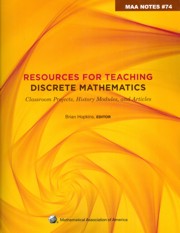Book contents
- Frontmatter
- Introduction
- Dedication
- Contents
- I Classroom-tested Projects
- II Historical Projects in Discrete Mathematics and Computer Science
- Introduction
- Binary Arithmetic: From Leibniz to von Neumann
- Arithmetic Backwards from Shannon to the Chinese Abacus
- Pascal's Treatise on the Arithmetical Triangle: Mathematical Induction, Combinations, the Binomial Theorem and Fermat's Theorem
- Early Writings on Graph Theory: Euler Circuits and The Königsberg Bridge Problem
- Counting Triangulations of a Convex Polygon
- Early Writings on Graph Theory: Hamiltonian Circuits and The Icosian Game
- Are All Infinities Created Equal?
- Early Writings on Graph Theory: Topological Connections
- A Study of Logic and Programming via Turing Machines
- Church's Thesis
- Two-Way Deterministic Finite Automata
- III Articles Extending Discrete Mathematics Content
- IV Articles on Discrete Mathematics Pedagogy
- About the Editor
Arithmetic Backwards from Shannon to the Chinese Abacus
from II - Historical Projects in Discrete Mathematics and Computer Science
- Frontmatter
- Introduction
- Dedication
- Contents
- I Classroom-tested Projects
- II Historical Projects in Discrete Mathematics and Computer Science
- Introduction
- Binary Arithmetic: From Leibniz to von Neumann
- Arithmetic Backwards from Shannon to the Chinese Abacus
- Pascal's Treatise on the Arithmetical Triangle: Mathematical Induction, Combinations, the Binomial Theorem and Fermat's Theorem
- Early Writings on Graph Theory: Euler Circuits and The Königsberg Bridge Problem
- Counting Triangulations of a Convex Polygon
- Early Writings on Graph Theory: Hamiltonian Circuits and The Icosian Game
- Are All Infinities Created Equal?
- Early Writings on Graph Theory: Topological Connections
- A Study of Logic and Programming via Turing Machines
- Church's Thesis
- Two-Way Deterministic Finite Automata
- III Articles Extending Discrete Mathematics Content
- IV Articles on Discrete Mathematics Pedagogy
- About the Editor
Summary
Recall that in the 1945 white paper “First Draft of a Report on the EDVAC” (Electronic Discrete Variable Automatic Computer), John von Neumann (1903–1957) advocated the use of binary arithmetic for the digital computers of his day. Vacuum tubes afforded these machines a speed of computation unmatched by other calculational devices, with von Neumann writing: “Vacuum tube aggregates … have been found reliable at reaction times as short as a microsecond …” [7, p. 188].
Predating this, in 1938 Claude Shannon (1916–2001) published a ground-breaking paper “A Symbolic Analysis of Relay and Switching Circuits” [4] in which he demonstrated how electronic circuits can be used for binary arithmetic, and more generally for computations in Boolean algebra and logic. These relay contacts and switches performed at speeds slower than vacuum tubes. Shannon identified an economy of representing numbers electronically in binary notation as well as an ease for arithmetic operations, such as addition. These advantages of base two arithmetic are nearly identical to those cited by von Neumann. Shannon [4] writes:
A circuit is to be designed that will automatically add two numbers, using only relays and switches. Although any numbering base could be used the circuit is greatly simplified by using the scale of two. […]
- Type
- Chapter
- Information
- Resources for Teaching Discrete MathematicsClassroom Projects, History Modules, and Articles, pp. 179 - 184Publisher: Mathematical Association of AmericaPrint publication year: 2009



